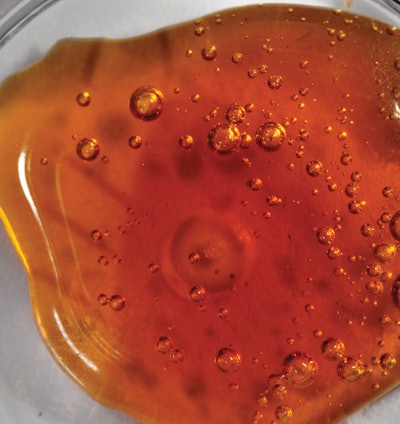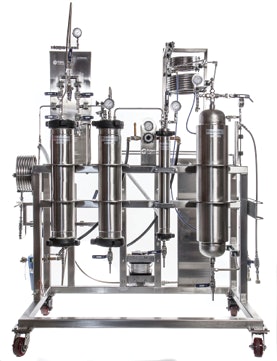
Is it time to diversify? Growers who aren’t at least considering the production of extracts could quickly lose ground to competitors. In the future, only 10 percent to 25 percent of cannabis will be sold in the form of dried and cured raw product, says Kenneth Morrow, owner of Trichome Technologies, a cannabis research and development company. Extracts will comprise the remainder of the market.
While the extraction market holds much promise, growers have many factors to consider before investing in extraction equipment, which can cost anywhere from a few thousand dollars to upwards of $500,000. The following questions and answers provide basic tips on how to get started.
1. What’s the best extraction method?
The short answer: All of them. The major extraction processes involve the use of hydrocarbons (butane or propane) and CO2. Other methods that offer smaller yields include ice water for the production of bubble hash, ethanol or alcohol and, more recently, rosin presses. There are pros and cons to each method, says Andy Joseph, president, Apeks Supercritical. “There really isn’t one method that’s better than another,” says Joseph, whose company produces mostly CO2 equipment and some ethanol extractors. The process a cultivator selects, however, will have an impact on quality, yields, productivity and legal/safety requirements.
For example, CO2 is considered safer and has the perception of being a “cleaner” extraction method than hydrocarbons. But the equipment is more expensive, and the processing time is two to three times slower than hydrocarbons, Morrow says. Cultivators who want to appeal to a wide market will likely want to consider all methods. “It’s product diversification like everything else,” Morrow says.
Joseph suggests visiting potential customer sites, such as dispensaries, to see what products they’re selling, because demand can vary in different geographic areas. “If they’re selling more butane and propane (based products), that’s the way you need to go,” he says. “If they’re selling more CO2, that’s the way to go.”
2. How much does the typical extractor cost?
Cost depends on a number of factors, including the preferred extraction method, volume and desired speed.
CO2 cost estimates: Apeks Supercritical, based in Johnstown, Ohio, sells CO2 equipment that ranges from $39,000 to $475,000. The company’s top-selling equipment is its mid-range production series, which costs $108,000 to $168,000 and processes 22 lbs. to 30 lbs. of cannabis per day, Joseph says. The company’s high-production series will process 80 lbs. to 100 lbs. per day at a price range of $194,000 to $475,000.
Hydrocarbon cost estimates: By comparison, Precision Extraction Solutions’ entry-level hydrocarbon processor costs $35,000 and produces 40 lbs. per day, says Nick Tennant, founding partner of the Royal Oak, Mich.-based company. The company’s largest extractor costs $200,000 and has a throughput of about 400 lbs., he says.
Other extraction technologies: Other types of equipment to consider are ethanol extractors and rosin presses. An alcohol extractor that processes 5 lbs. to 10 lbs. of material costs about $10,000, plus another $5,000 to $50,000 for a fume hood, depending on the size, Joseph says. The drawback to ethanol, though, is there are more processing steps involved than CO2, says Fritz Chess, founder of Seattle-based Eden Labs LLC, a maker of CO2 and distillation extraction equipment.
One technology that’s growing in popularity, but processes much smaller volumes is rosin presses. “The cost of production is minimal, but it’s hard to produce a lot,” Morrow says. The price range for rosin presses is about $5,000 to $12,000, Chess says.
3. What are the safety risks?
The equipment, however, isn’t the only cost factor to consider. Safety is perhaps the most important factor in extraction. Hazardous situations are costly and potentially deadly. In April, the Occupational Safety and Health Administration (OSHA) fined New MexiCann Natural Medicine $13,500 after it found 12 serious health violations following a July 2015 explosion that badly burned two employees, according to the Associated Press.
Hydrocarbon safety: Because hydrocarbons are flammable, hydrocarbon processors may require facility upgrades/safety measures that add to the expense, Joseph says. This includes set up for a Class 1, Division 1 compliant room, which will cost $20,000 to $50,000, depending on the size of the room and location, Joseph says. (Class 1, Division 1 is one class of an OSHA classification for “Safety and Health Regulations for Construction,” which “sets forth requirements for electric equipment and wiring in locations which are classified depending on the properties of the flammable vapors, liquids or gases, or combustible dusts or fibers which may be present,” per the OSHA website.)
CO2 safety: On the other hand, CO2 extraction uses liquid CO2 rather than a flammable solvent, Morrow says. For CO2 equipment, cultivators should ensure the extractors don’t use sanitary piping and fittings for the separators, which separates the oil from the CO2, Chess says. Many CO2 systems use sanitary piping because it’s less costly, he says, as well as corrosion-resistant, but it also has safety risks.
Sanitary piping is prone to fatigue and failure because of its low-pressure rating, which is about 600 psi (for minimum burst pressure), Chess says. Separators should be constructed of Schedule 80 stainless steel pipe, which he says has an estimated 2,000 psi rating. Also consider systems that have been certified by a third-party engineer, Chess says.
4. How will different methods impact quality?
CO2 typically produces a more flavorless extract, Morrow says. It also requires further refinement because it carries more chlorophyll, wax and undesirable compounds than hydrocarbon extraction, he says.
Light hydrocarbons are effective because they’re strong, nonpolar solvents that bind to the cannabinoid structure and terpene of the plant, Tennant says. (Terpenes make up the essential volatile oils that produce the cannabis scent.)
Other solvents, such as ethanol, may bind to the chlorophyll or cellular structure, which leaves a darker color and less-desirable taste, Tennant says.
Some systems are better at making particular products, as well. For example, typically, hydrocarbon systems can make shatter fairly easily, says Joseph. CO2 extractors typically utilize heat, which makes shatter production difficult. However, CO2 systems with cold-separation technology are less likely to cause thermal degradation to the product, Joseph says.

5. Who can help you get started?
Most cultivators will likely need help understanding how production goals and new regulations will impact equipment selection. Consultants with extraction expertise can provide guidance on code compliance, safety and engineering specifications, and operational procedures, Tennant says. A qualified consultant also should be able to provide a referral list that demonstrates speed of approval, code compliance and other key measures of success.
Also, cultivators should consider hiring personnel with extraction expertise, suggests Morrow. “A typical grower should focus on growing — not extracting. It’s too late to go to school for that. Hire someone qualified to do that for you, especially at this point in legal regulation,” Morrow says. “Those people are available. … There’s no way you can run your business, grow your pot, extract and sell at the same time.”
















